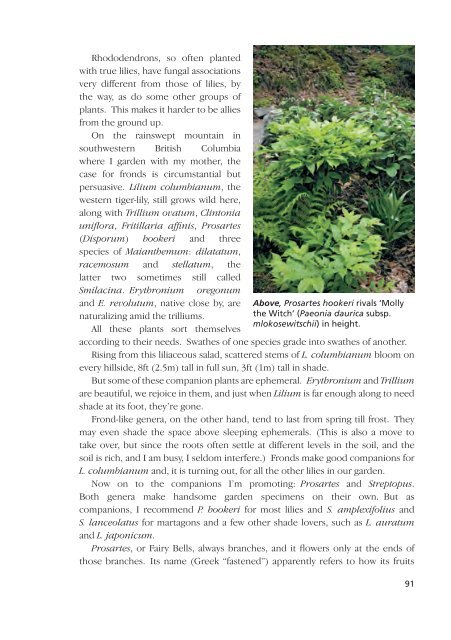Lilies and Related Plants - RHS Lily Group
Lilies and Related Plants - RHS Lily Group
Lilies and Related Plants - RHS Lily Group
Create successful ePaper yourself
Turn your PDF publications into a flip-book with our unique Google optimized e-Paper software.
Rhododendrons, so often planted<br />
with true lilies, have fungal associations<br />
very different from those of lilies, by<br />
the way, as do some other groups of<br />
plants. This makes it harder to be allies<br />
from the ground up.<br />
On the rainswept mountain in<br />
southwestern British Columbia<br />
where I garden with my mother, the<br />
case for fronds is circumstantial but<br />
persuasive. Lilium columbianum, the<br />
western tiger-lily, still grows wild here,<br />
along with Trillium ovatum, Clintonia<br />
uniflora, Fritillaria affinis, Prosartes<br />
(Disporum) hookeri <strong>and</strong> three<br />
species of Maianthemum: dilatatum,<br />
racemosum <strong>and</strong> stellatum, the<br />
latter two sometimes still called<br />
Smilacina. Erythronium oregonum<br />
<strong>and</strong> E . revolutum, native close by, are<br />
naturalizing amid the trilliums.<br />
All these plants sort themselves<br />
Above, Prosartes hookeri rivals ‘Molly<br />
the Witch’ (Paeonia daurica subsp.<br />
mlokosewitschii) in height.<br />
according to their needs. Swathes of one species grade into swathes of another.<br />
Rising from this liliaceous salad, scattered stems of L . columbianum bloom on<br />
every hillside, 8ft (2.5m) tall in full sun, 3ft (1m) tall in shade.<br />
But some of these companion plants are ephemeral. Erythronium <strong>and</strong> Trillium<br />
are beautiful, we rejoice in them, <strong>and</strong> just when Lilium is far enough along to need<br />
shade at its foot, they’re gone.<br />
Frond-like genera, on the other h<strong>and</strong>, tend to last from spring till frost. They<br />
may even shade the space above sleeping ephemerals. (This is also a move to<br />
take over, but since the roots often settle at different levels in the soil, <strong>and</strong> the<br />
soil is rich, <strong>and</strong> I am busy, I seldom interfere.) Fronds make good companions for<br />
L . columbianum <strong>and</strong>, it is turning out, for all the other lilies in our garden.<br />
Now on to the companions I’m promoting: Prosartes <strong>and</strong> Streptopus.<br />
Both genera make h<strong>and</strong>some garden specimens on their own. But as<br />
companions, I recommend P . hookeri for most lilies <strong>and</strong> S . amplexifolius <strong>and</strong><br />
S . lanceolatus for martagons <strong>and</strong> a few other shade lovers, such as L . auratum<br />
<strong>and</strong> L . japonicum.<br />
Prosartes, or Fairy Bells, always branches, <strong>and</strong> it flowers only at the ends of<br />
those branches. Its name (Greek “fastened”) apparently refers to how its fruits<br />
91




